

 STUART JORDAN looks back at the history of this London terminal.
STUART JORDAN looks back at the history of this London terminal.
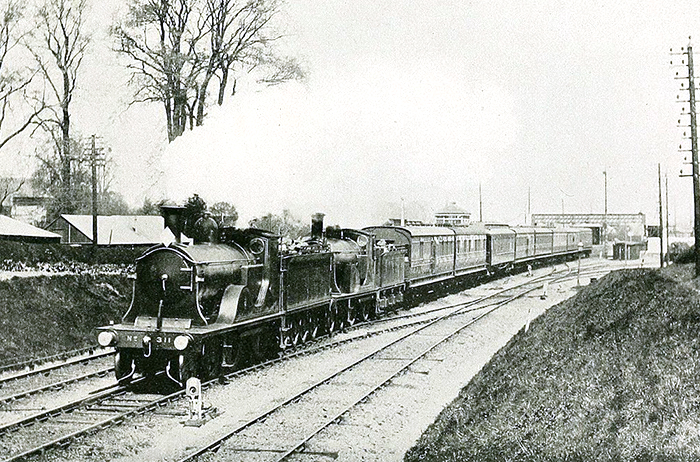
LSWR London to Southampton Boat Train, around 1911.
London Waterloo is a station which serves as the northern terminus of several main lines: the South Western to Weymouth via Southampton, the West of England to Exeter via Salisbury, and the Portsmouth Direct line, as well as many commuter lines in South Eastern England.
Waterloo is located on the south bank of the Thames near to Waterloo Bridge – the station is named after the bridge, and the bridge is named after the battle! The station is also by Westminster Bridge, just across the river from the Houses of Parliament.
The original London terminus of the London and South Western Railway (LSWR) was Nine Elms station in Battersea, which opened in 1838. The line ran from Southampton but was not suitable for commuter traffic as it was some distance from the centre of London. A site was found close to Waterloo Bridge and an Act of Parliament was obtained in 1845 to extend the line. Although most of the new line was carried on brick viaducts, 700 houses were demolished.
The station was named for the bridge, rather than the battle, as indicated by the original name which was Waterloo Bridge Station. The station building, which opened in 1848, was designed by William Tite; a prolific railway architect working in the Italianate style.
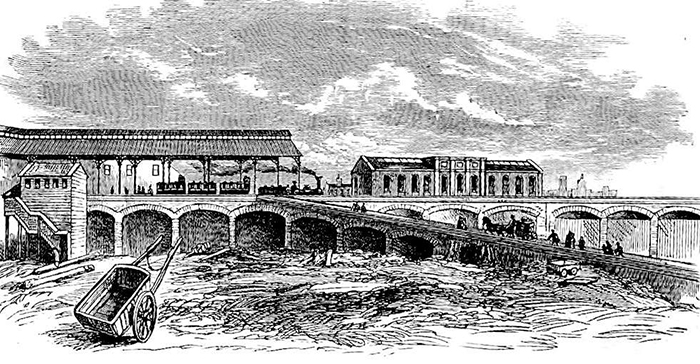
The original station as it looked in 1848.
The station wasn’t planned as a terminus – the intention was to eventually continue the line into the City of London itself. Because of this, the expansion of Waterloo was ad hoc and seen as temporary – eventually being superseded once the line was extended. Passenger demand increased and extra platforms and lines were built throughout the 1860s, including new platforms on the northeast side for trains to Windsor, a link to the South East Railway line from London Bridge to Charing Cross, with other extensions to the south-east and north opened in 1878 and 1885 respectively. The confusing layout and stations-within-a-station led to Waterloo being a subject of jokes in music hall songs and satirical magazines.
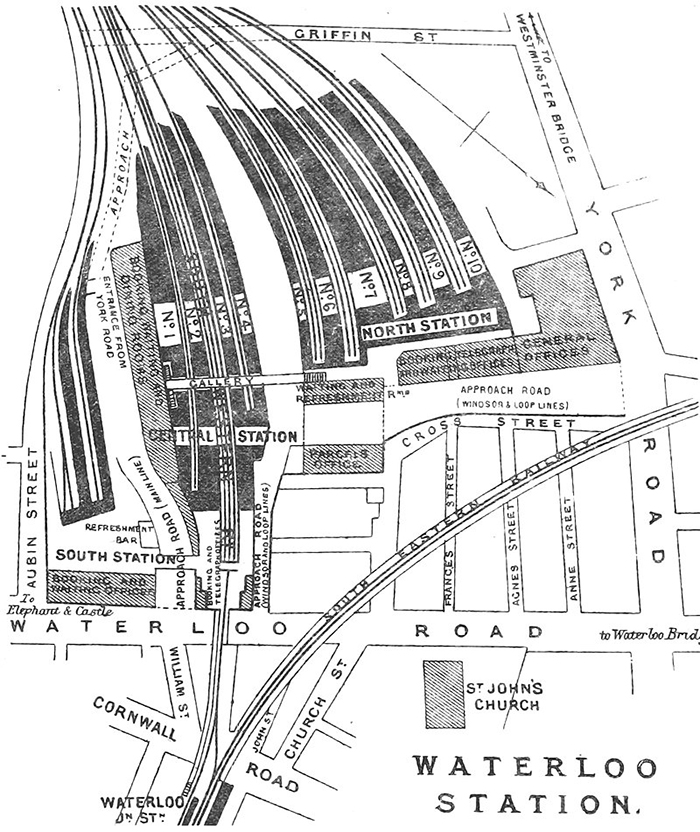
Platform plan of the original station, made in 1888.
Throughout this period, the LSWR were trying to finalise the plans for expansion line to the City. Plans for an overhead line were repeatedly rejected due to cost. This led, instead, to the construction of the Waterloo & City tube line, which opened in 1898 and ran under the Thames to Bank-Monument Station. Waterloo would now stay a terminus and the LSWR had their direct commuter link to Central London.
Focus turned to improving the station itself, now that it was confirmed that it would be a terminus rather than a through station. LSWR called the plan ‘The Great Transformation’, in an effort to generate some positive publicity for the much-maligned station. In 1900, an area of around 6.2 acres was purchased to accommodate the new building. The land (around six streets) was cleared, displacing approximately 1,750 people, who were housed in new blocks of flats built by the LSWR.
Construction continued throughout the early years of the century, with the main booking hall opening in 1911, through the First World War with the station opening completely in 1922. The new Waterloo had 21 platforms and a 700ft concourse. Despite the construction work, Waterloo was a main marshalling depot for troops heading to France via Southampton during the First World War. The main foot entrance on the north side of the building was surrounded by the Victory Arch; a monument to the 585 LSWR employees killed during the war, flanked by statues of the Roman goddesses Bellona - representing war - and Pax, representing peace.
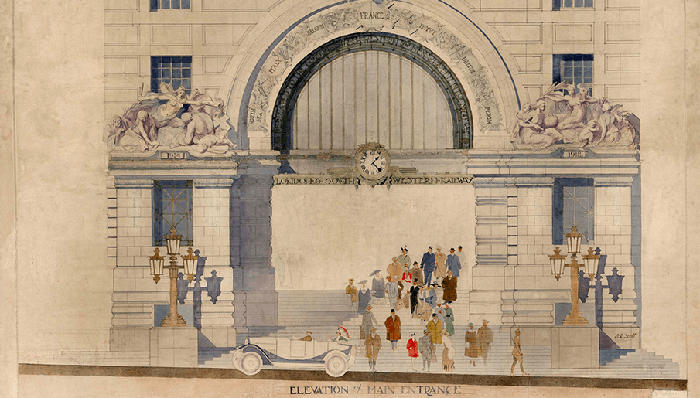
The Victory Arch.
Shortly before the 1929 Grouping, LSWR started electrifying suburban services. Third rails were added to routes to Wimbledon, Shepperton, and Hampton Court. Once it took over the running of the station, Southern Railway (SR) pushed through electrification on all routes out of Waterloo, not just suburban lines. By the late 1930s, routes to Guildford, Portsmouth Harbour, Aldershot, and Reading were all electrified. The Aldershot branch was particularly important, as it was thought that strengthening the link of this military town to London was prudent with the anticipated outbreak of war.
Waterloo was damaged by bombing several times during the Second World War, with one notable occasion when on 7th September 1940, the first day of the Blitz, the John Street Viaduct just outside the station was destroyed by bombing. Trains could not run for 12 days and 5000 mailbags piled up on the platforms.
The railways were Nationalised in 1948, and Waterloo became part of the Southern Region of British Railways. BR continued the electrification programme that Southern had accelerated, but Waterloo was still the last London terminus to run a steam service. It was Sunday 9th July, 1967. The last steam-hauled passenger train to the capital was pulled by Merchant Navy 35030 ‘Elder Dempster Lines’, which was also the last of the Merchant Navy Class to be built.
Network SouthEast managed the station under BR. After privatisation, ownership of Waterloo passed to Railtrack in 1994 and then Network Rail in 2002. When the Channel Tunnel was completed in 1994, the planned London terminal in the north of London had not yet been constructed. It was decided to convert platforms 20-24 to form Waterloo International while the new Channel Tunnel Rail Link to St Pancras was constructed. This was completed in 2007 and Waterloo closed to international services. The international platforms were brought back into domestic use, including in 2010 when some of the disused platforms hosted a production of The Railway Children. The audience was sat either side of the tracks and real rolling stock was used.
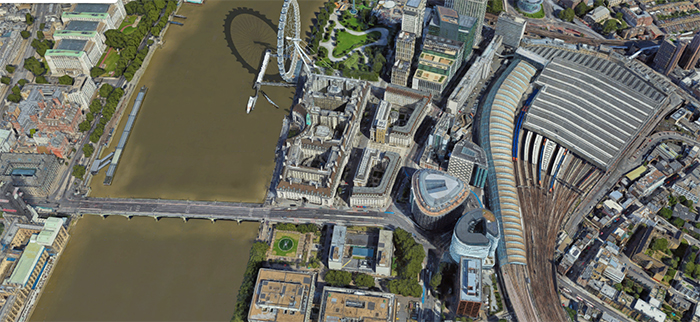
Overhead view of the current station, showing its location on the near to the South Bank. The London Eye (top) and Houses of Parliament (bottom-left) show Waterloo's Central London location. (Image source: Google)
Waterloo remains the busiest station in the UK, and has the largest floor space and more platforms (24) than any other station in the UK. Following Eurostar’s departure, the station is currently used by South Western Railway for suburban services around London and passenger services around south of England as far west as Exeter. South Eastern services to East Sussex and Kent run from the adjacent Waterloo East station. Waterloo Underground station has connections to the Bakerloo, Northern, Jubilee, and the Waterloo and City lines.
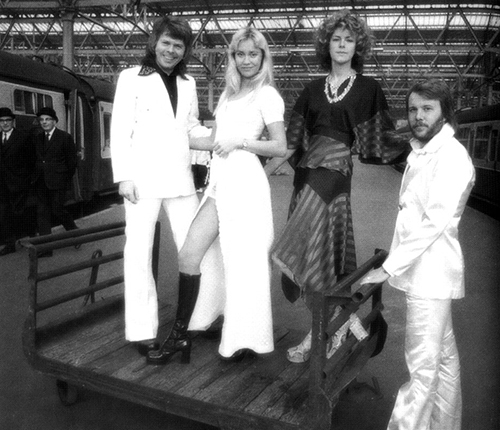
How can I write an article about Waterloo and not mention ABBA? Here is the group at a promotional photoshoot at Waterloo, shortly after winning the 1974 Eurovision Song Contest in Brighton, with their song of the same name.